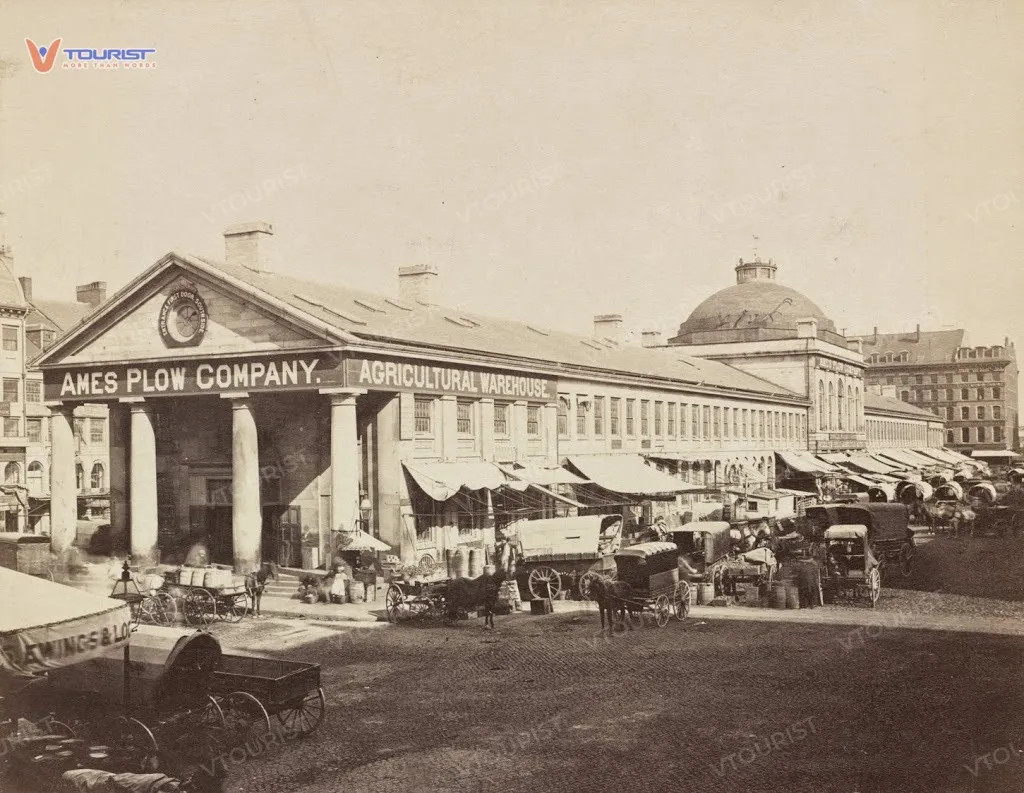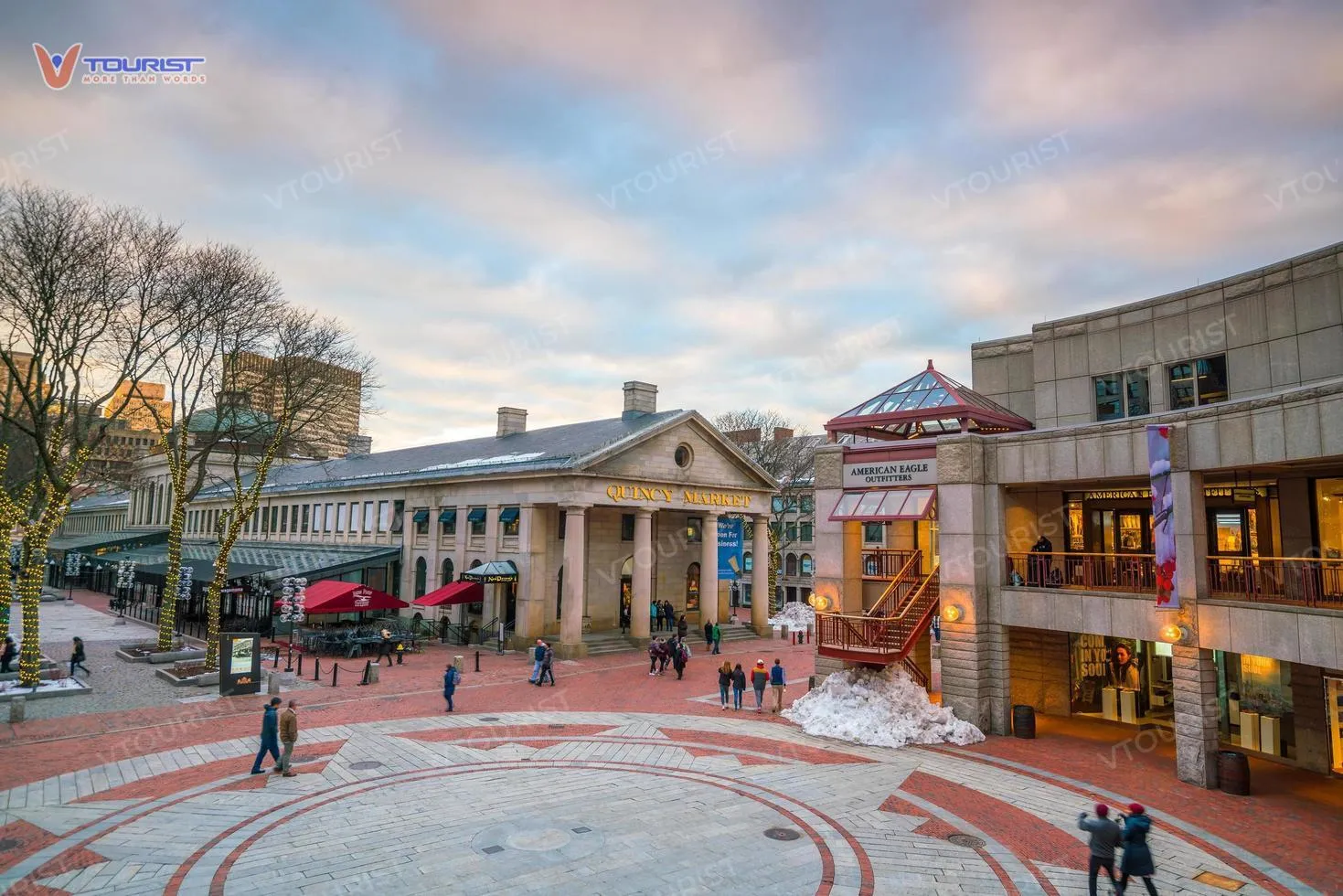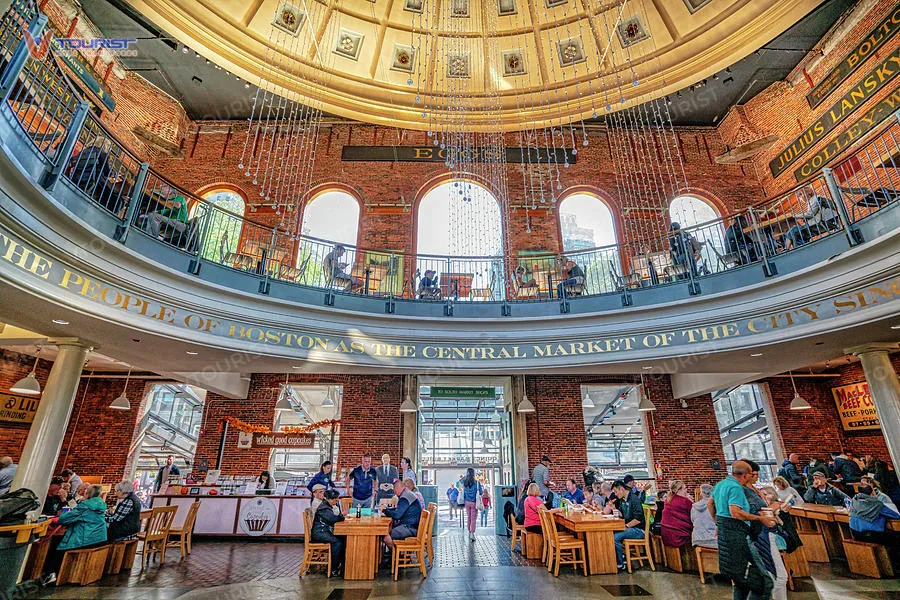Boston, an ancient city rich in history and culture, is renowned not only for its historical landmarks, museums, and prestigious universities but also as a haven for unique culinary and shopping experiences. In the heart of this vibrant city, Quincy Market stands as a long-standing commercial icon, where visitors and locals alike can immerse themselves in the bustling atmosphere, discover fresh local produce, and enjoy a quintessential Boston shopping experience. Join “Du lịch khắp thế gian” as we explore the exciting things awaiting you at this special farmers market!
Quincy Market – A Unique Shopping Destination in the Heart of Boston
Located in downtown Boston, Massachusetts, Quincy Market is more than just a typical marketplace; it’s a living historical landmark, a testament to the city’s commercial development over centuries. Its prime location near Faneuil Hall, another famous Boston landmark, further enhances Quincy Market’s appeal. The market spans a large area, encompassing the grand Quincy Market building and the two flanking structures, North Market and South Market, creating a unique and impressive architectural ensemble. Beyond being a bustling trading hub, Quincy Market is also a cultural center, hosting community events, street performances, and festivals, offering a diverse and enriching experience for every visitor.
History of Quincy Market and Its Role as a Farmers Market in Boston

Quincy Market was built in 1826, marking a significant turning point in Boston’s commercial history. In the early 19th century, as Boston experienced rapid growth, Faneuil Hall Market, the city’s main trading center, became overcrowded. To meet the increasing commercial demand, city authorities decided to build a new, larger, and more modern market. The talented architect Alexander Parris was entrusted with designing this project. He created an architectural masterpiece named Quincy Market, after Mayor Josiah Quincy Jr., who played a key role in promoting the market’s construction.
Initially, Quincy Market was primarily planned as a farmers and food market, focusing on fresh produce from across New England and beyond. Farmers, fishermen, and food producers brought their best products to the market, from fresh vegetables and fruits, fresh seafood and meat to cheeses, breads, and local specialties. Quincy Market quickly became the main food supplier for Bostonians and surrounding areas, playing a vital role in economic development and ensuring food security for the city. Over time, Quincy Market not only maintained its role as a farmers market but also expanded into many other commercial areas, becoming a versatile and attractive market, drawing tourists and locals to shop, dine, and enjoy entertainment.
Unique Architecture of Quincy Market – A Blend of Classic and Modern

The architecture of Quincy Market is a blend of classic and modern styles, creating a unique and impressive aesthetic. The main Quincy Market building is a massive structure, 163 meters long and 2500 square meters wide, built primarily of granite and glass. The Neoclassical architectural style is evident in the east and west facades of the market, with triangular pediments and majestic Doric columns, reminiscent of ancient Roman architecture. However, Quincy Market also embodies modern elements, reflected in the use of glass and steel structures, creating open and airy spaces inside.
Inside the market, cast iron columns and iron tie rods are used creatively, optimizing space and creating a spacious feel for the shopping area. The prominent copper dome on the market’s roof is not only a unique architectural detail but also a symbol of Quincy Market, easily recognizable from afar. The two flanking buildings, North Market and South Market, built of brick and granite, add more space to the market area and create a harmonious and unified architectural ensemble. The harmonious combination of classic and modern styles in Quincy Market’s architecture not only provides aesthetic beauty but also reflects the intersection of past and present, tradition and innovation, creating a unique and charming shopping space.
Shopping Paradise at Quincy Market: Fresh Produce and Local Specialties
Quincy Market is not only a historical landmark and unique architecture but also a diverse shopping paradise, especially for those who love fresh produce and local specialties. Stepping into Quincy Market, you will be overwhelmed by countless stalls selling all kinds of products, from fresh produce, seafood, poultry to prepared foods, souvenirs, clothing, and jewelry.
Seasonal Fresh Produce

Quincy Market is an ideal place to find fresh seasonal produce from the New England region. In the summer, you can find juicy blueberries, ripe red strawberries, fragrant peaches, and sweet yellow corn. As autumn arrives, the market is filled with apples, pumpkins, sweet potatoes, and typical autumn harvest vegetables and fruits. Produce at Quincy Market always ensures fresh quality, harvested directly from local farms and transported to the market daily. You can shop directly from farmers, learn about the origin and production process of products, and support local agriculture.
Fresh Seafood
Boston is famous as a coastal city with abundant and fresh seafood. Quincy Market is one of the best places to enjoy fresh seafood in Boston. Seafood stalls at the market sell all kinds of shrimp, crab, clams, snails, fish, and squid, caught directly from the sea and transported to the market every day. You can buy fresh seafood to prepare yourself or enjoy prepared seafood dishes at restaurants and eateries in the market. Boston’s famous Clam Chowder is a must-try dish when visiting Quincy Market.
Boston Culinary Specialties
In addition to fresh produce and seafood, Quincy Market is also a gathering place for many Boston and New England culinary specialties. You can find Lobster Rolls, Apple Pie, Boston Cream Pie, fudge, and many other delicious dishes. Food stalls at Quincy Market offer a variety of flavors and styles, from traditional American cuisine to international dishes. You can enjoy lunch or dinner at the market, experience the vibrant street food atmosphere, and discover the unique flavors of Boston.
Souvenirs and Handicrafts

If you are looking for unique souvenirs with a distinct Boston touch, Quincy Market is a must-visit destination. Souvenir shops at the market sell a wide variety of products, from t-shirts, hats, keychains, decorations to handicrafts, paintings, and leather goods. You can find lovely little gifts for friends and family, or shop for unique items to commemorate your trip to Boston. In particular, handicrafts and leather goods at Quincy Market are meticulously handcrafted and sophisticated, imbued with local art and culture.
Tips for a Great Shopping Experience at Quincy Farmers Market
To have a complete and enjoyable shopping experience at Quincy Farmers Market, you can refer to some helpful tips below:
Best Time to Visit
Quincy Market is open daily, but the best time to visit is on weekends or during festivals. At these times, the market becomes more bustling and lively with many street performances, cultural events, and food festivals. If you want to avoid crowds, you can visit the market on weekdays or early in the morning.
Getting to the Market
Quincy Market is located in downtown Boston, very easy to get to by public transport such as subway, bus, or taxi. You can take the Green or Blue subway line to Government Center or State Street station, then walk a few minutes to Quincy Market. If you take the bus, there are many bus routes that stop near Quincy Market. If you drive a private car, there are several parking lots near the market, but parking fees can be quite high, especially on weekends.
Smart Shopping Tips
When shopping at Quincy Market, you should take time to stroll around the market, explore the stalls, and compare prices before deciding to buy. You can also ask vendors for advice about products, especially fresh produce and food. If you buy in large quantities, you can negotiate prices with vendors. Don’t forget to try free samples at food stalls and enjoy the bustling atmosphere of the market.
Combine Visiting Nearby Attractions

Quincy Market is located near many other attractive Boston destinations, such as Faneuil Hall, the Freedom Trail, Boston Common, and Boston Harbor. You can combine visiting Quincy Market with these destinations for a complete and enjoyable day exploring Boston. After shopping and dining at Quincy Market, you can walk along the Freedom Trail to explore important historical sites in Boston, or relax in the green Boston Common park.
Conclusion: Quincy Market – More Than Just a Farmers Market, a Boston Cultural Icon
Quincy Market is not just a typical farmers market but also a cultural and historical icon of Boston. It is not only an ideal shopping destination with fresh produce and local specialties but also a place where visitors can immerse themselves in the bustling atmosphere, experience local culture, and discover unique historical values. Come to Quincy Market to feel the vibrant rhythm of Boston, enjoy unique cuisine, and bring back meaningful souvenirs for your trip. Quincy Market will surely be an unforgettable shopping experience on your journey to discover Boston.